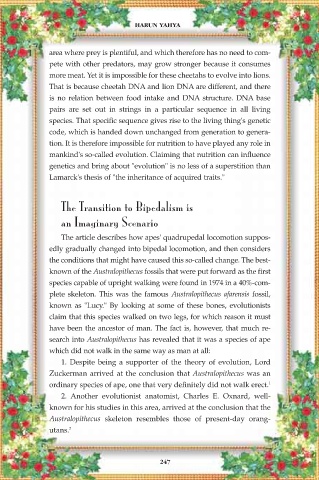Page 249 - A Definitive Reply to Evolutionist Propaganda
P. 249
HARUN YAHYA
area where prey is plentiful, and which therefore has no need to com-
pete with other predators, may grow stronger because it consumes
more meat. Yet it is impossible for these cheetahs to evolve into lions.
That is because cheetah DNA and lion DNA are different, and there
is no relation between food intake and DNA structure. DNA base
pairs are set out in strings in a particular sequence in all living
species. That specific sequence gives rise to the living thing's genetic
code, which is handed down unchanged from generation to genera-
tion. It is therefore impossible for nutrition to have played any role in
mankind's so-called evolution. Claiming that nutrition can influence
genetics and bring about "evolution" is no less of a superstition than
Lamarck's thesis of "the inheritance of acquired traits."
The Transition to Bipedalism is
an Imaginary Scenario
The article describes how apes' quadrupedal locomotion suppos-
edly gradually changed into bipedal locomotion, and then considers
the conditions that might have caused this so-called change. The best-
known of the Australopithecus fossils that were put forward as the first
species capable of upright walking were found in 1974 in a 40%-com-
plete skeleton. This was the famous Australopithecus afarensis fossil,
known as "Lucy." By looking at some of these bones, evolutionists
claim that this species walked on two legs, for which reason it must
have been the ancestor of man. The fact is, however, that much re-
search into Australopithecus has revealed that it was a species of ape
which did not walk in the same way as man at all:
1. Despite being a supporter of the theory of evolution, Lord
Zuckerman arrived at the conclusion that Australopithecus was an
ordinary species of ape, one that very definitely did not walk erect. 1
2. Another evolutionist anatomist, Charles E. Oxnard, well-
known for his studies in this area, arrived at the conclusion that the
Australopithecus skeleton resembles those of present-day orang-
utans. 2
247

